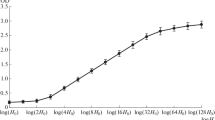Abstract
Interphase macronuclear chromatin of the ciliate Bursaria truncatella was studied on spread preparations of individual nuclei isolated at different times after vegetative division. During the period from 0.5 to 3 h after cell division most of the macronuclear chromatin was in the decompacted state and had the appearance of loose agglomerations of fibers in regions where transcriptional complexes were observed. The maximum amount of decompacted chromatin was observed 0.5–1.5 h after cell division. At 2–3 h after division the amount of decompacted chromatin decreased as the amount of compact chromatin organized in clumps 0.12–0.18 μm in diameter increased. Macronuclei from cells that had finished growing and differentiating contained practically only linked chromatin clumps. Electron microscopic autoradiography showed that chromatin organized in clumps was transcriptionally inactive. Transcription only took place in decompacted chromatin agglomerations. Characteristic features of the structure of transcriptionally active genes in B. truncatella are described in detail.
Similar content being viewed by others
References
Berger S, Zellmer DH, Kloppstech K, Richter G (1978) Alternating polarity in rRNA genes. Cell Biol Intern Reports 2:41–50
Borkhadt B, Nielsen OF (1981) An electron microscopic analysis of transcription of nucleolar chromatin isolated from Tetrahymena pyriformis. Chromosoma 84:131–143
Bouteille M, Dupuy-Coin AM, Moyne G (1975) Techniques of localization of proteins and nucleoproteins in the cell nucleus by high resolution autoradiography and cytochemistry. In: BW O'Malley (ed) Methods in enzymology, vol XL, part E. Academic Press, New York, pp 3–44
Diaz de la Espina SM, Franke WW, Krohne G, Trendelenburg MF, Grund C, Scheer U (1982) Medusoid fibril bodies: a novel type of nuclear filament of diameter 8 to 12 μm with periodic ultrastructure demonstrated in oocytes of Xenopus laevis. Eur J Cell Biol 27:141–150
Franke WW, Scheer U, Trendelenberg M, Zentgraf H, Spring H (1978) Morphology of transcriptionally active chromatin. Cold Spring Harbor Symp Quant Biol 42:755–772
Franke WW, Scheer U, Spring H, Trendelenburg MF, Zentgraf H (1979) Organization of nucleolar chromatin. In: Busch H (ed) The cell nucleus, vol 7. Academic Press, New York London, pp 49–95
Gorovsky MA, Glover C, Johmann CA, Keevert JB, Mathis DJ, Samuelson M (1978) Histones and chromatin structure in Tetrahymena macro- and micronuclei. Cold Spring Harbor Symp Quant Biol 42:493–503
Lipps HJ, Morris NR (1977) Chromatin structure in the nuclei of the ciliate Stylonychia mytilus. Biochem Biophys Res Commun 74:230–234
Lipps HJ, Nock A, Riewe M, Steinbruck G (1978) Chromatin structure of the macronucleus of Stylonychia mytilus. Nucleic Acids Res 5:4699–4709
Martinkina LP, Sergejeva GI, Vengerov YY, Bespalova IA, Popenko VI, Tikhonenko AS (1981) The structural organization of chromatin in the macronucleus of the ciliate Bursaria truncatella. IV Symp USSR-FRG Structure and transcription of genome, Yerevan
Martinkina LP, Vengerov YY, Bespalova IA, Sergejeva GI, Tikhonenko AS (1983) Structure of inactive interphase macronuclear chromatin of a ciliate Bursaria truncatella: radial loops in structure of chromatin clumps. Europ J Cell Biol 30:47–53
McKnight SL, Miller OLJ (1977) Electron microscopic analysis of chromatin replication in the cellular blastoderm Drosophila melanogaster embryo. Cell 12:795–804
Miller OL Jr, Beatty BR (1969) Visualization of nucleolar genes. Science 164:955–957
Miller OL Jr, Beatty BR, Hamkalo BA, Thomas CA (1970) Electron microscopic visualization of transcription. Cold Spring Harbor Symp quant Biol 35:505–509
Ossipov DV (1981) Problems of nuclear heteromorphism in the unicellular organisms. Nauka, Leningrad
Raikov IB (1982) The protozoan nucleus: morphology and evolution. Cell Biol Monographs, vol 9. Springer, Wien New York
Salpeter MM, Bachmann L (1964) Autoradiography with electron microscope. J Cell Biol 22:469–477
Samuel Ch, Mackie J, Sommerville J (1981) Macronuclear chromatin organization in Paramecium primaurelia. Chromosoma 83:481–492
Sergejeva GI (1977) On the structure of macronuclear chromatin of ciliate Bursaria truncatella. Tsitologia 19:1146–1154
Sommerville J (1981) Immunolocalization and structural organization of nascent RNP. In: Busch H (ed) The cell nucleus, vol 8. Academic Press, New York London, pp 1–57
Author information
Authors and Affiliations
Rights and permissions
About this article
Cite this article
Vengerov, Y.Y., Sergejev, G.I., Martinkina, L.P. et al. Electron microscopic and autoradiographic study of the macronuclear chromatin of Bursaria truncatella at different times after cell division. Chromosoma 88, 328–332 (1983). https://doi.org/10.1007/BF00285855
Received:
Revised:
Issue Date:
DOI: https://doi.org/10.1007/BF00285855



